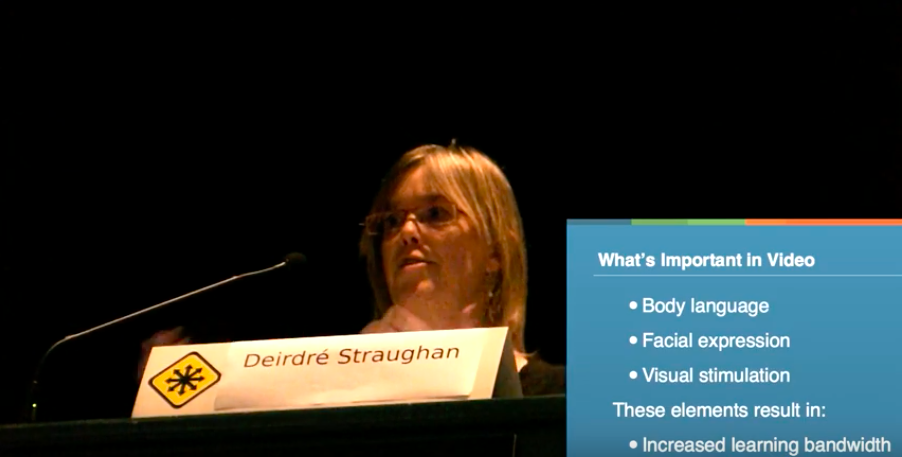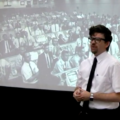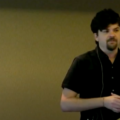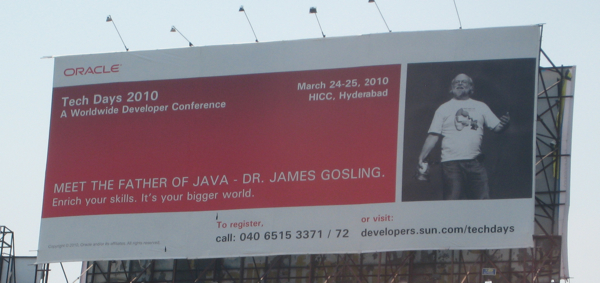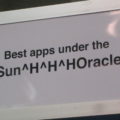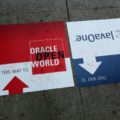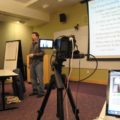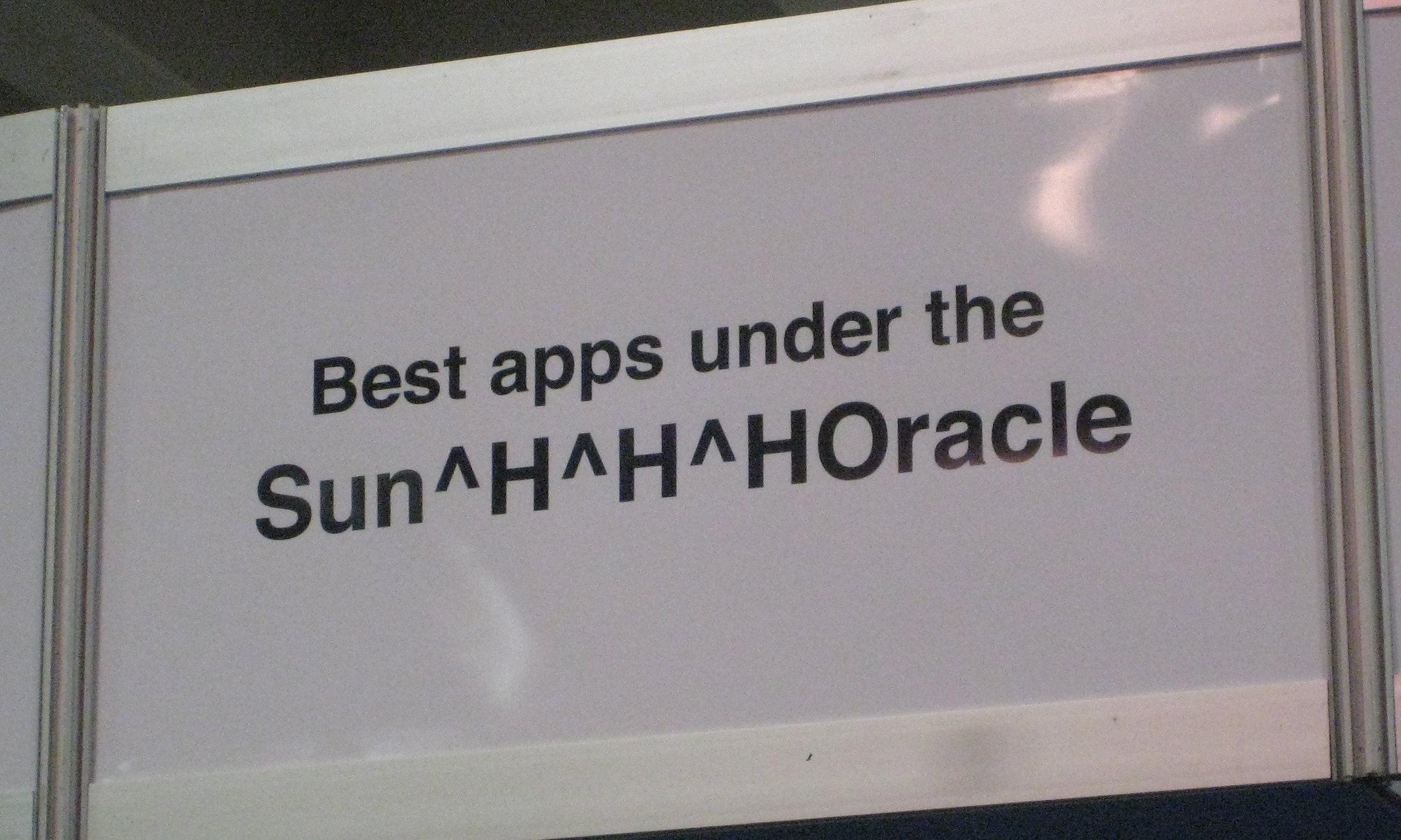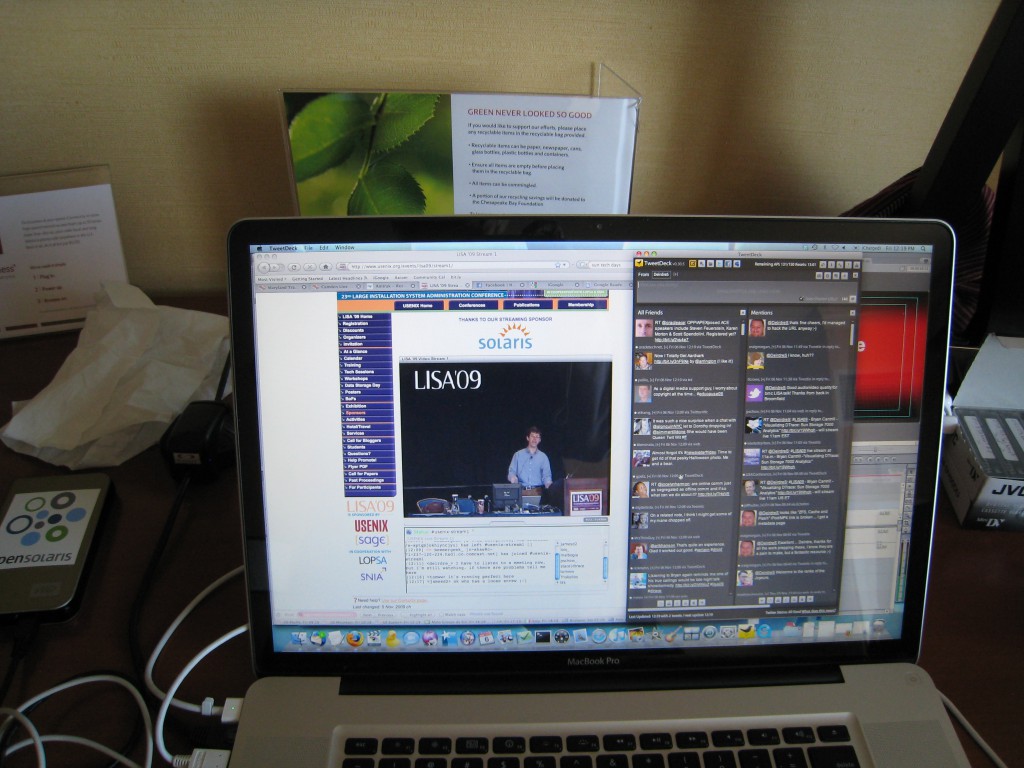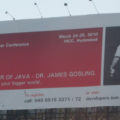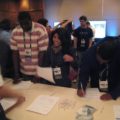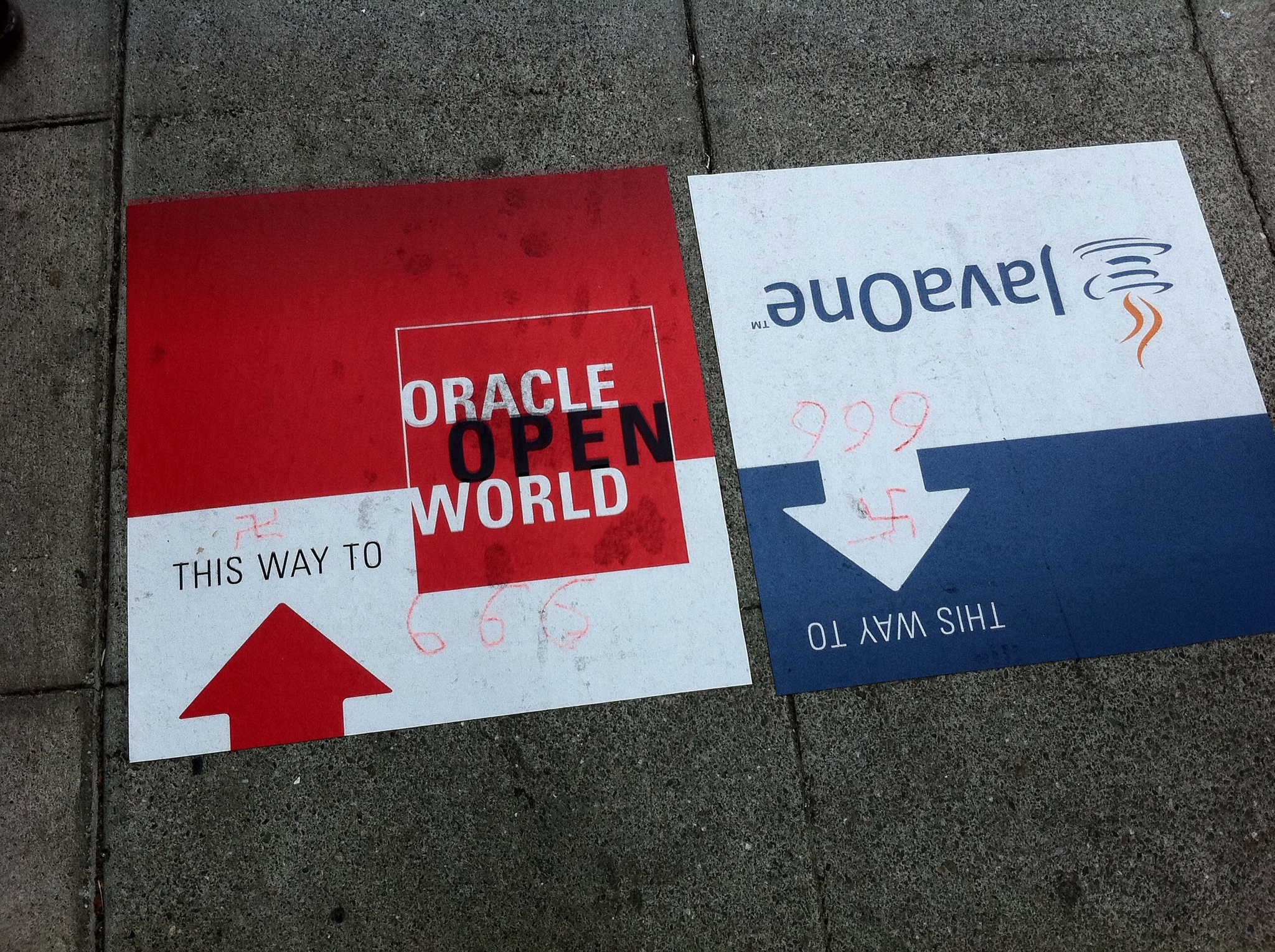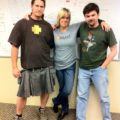For once, there’s video of me, talking about what I do and why I do it that way.
Tag Archives: what I do
Into the Belly of the Beast
(Part 4 of Resistance is Futile: The Oracle Acquisition)
The “change in control” from Sun to Oracle took place, in the US, on Feb 15, 2010. I visited the Oracle campus in Redwood Shores that day, invited by one of Oracle’s few sanctioned social media experts. As it happened, that was also the day that an Oracle support employee, wildly popular with customers for giving out support advice for free on Twitter and in a blog, was being shut down by the company, forbidden to provide answers outside the official – paid – support channels. It was clear that I wasn’t in Kansas anymore.
Soon thereafter, I was in Menlo Park for team meetings when I discovered that dozens of my videos had been deleted, without warning, from the BTV video hosting platform that had just been rebranded as Oracle’s. My colleagues heard my screams of anguish. I had not archived copies of those videos; that person in charge of Oracle media had not told me they would be removed (I rather thought she had implied that they would simply be rebranded). She gave no reason for the removal, and turned a deaf ear to my pleas that these were useful and perhaps irreplaceable original material, technologists talking about technology. The videos were still on a server somewhere, but I was never able to get a single one reposted. I hope there’s a special hell reserved for those who deliberately and maliciously destroy others’ work.
Her attitude was all too typical of what we experienced across Oracle, both at the corporate level and from many individuals. Oracle had been on an acquisitions spree, buying 50+ companies in five years and assimilating them with brutal efficiency. As far as I could tell, Oracle had no notion that it had once had its own corporate culture that might be worth preserving, let alone care that any of its targets did. That summer I met a former Oracle employee who had quit 18 months earlier, after 12 years with the company. “I didn’t recognize it anymore,” he said sadly. “After all the acquisitions began, it was no longer the Oracle I used to know and love.”
It was made very clear to us all that we were cogs in the machine and should not think too highly of ourselves. The only thing that mattered was profit, which was arrived at by carefully orchestrated process. Time after time we were told: “This is how it’s done here, get used to it” – sometimes in those very words. I had the impression that some victims of earlier acquisitions positively enjoyed putting us uppity Sun folk through the same miseries that they themselves had endured. Cherished ways and systems that had persisted for years at Sun – usually because they worked – were swept away with no regard for anything except The Rules.
Some particularly process-oriented former Sun people thrived in the new regime; most of us did not. For better and for worse, Sun’s creative, anarchic culture was the polar opposite of Oracle’s command-and-control style. It was soon clear that many of us, despite our best intentions to keep open minds and try to stand by the people and technologies we loved working with, would not be long for the Oracle world.
I have to hand it to Oracle: they were very canny about layoffs. Larry Ellison had claimed that “fewer than 1000” of Sun’s 30,000 employees would be laid off at acquisition. This was true – in north America. The change in control in other regions took place weeks or months later for various legal reasons, and many more layoffs happened in those areas, unnoticed by the US media. In some regions, salaries were simply cut so steeply (to match Oracle’s local salary ranges) that people left for other jobs as soon as they could find them.
I suspect that Oracle also skillfully identified the Sun employees to whom they didn’t need to offer layoff packages, because they would obviously quit anyway. In the cases of some that Oracle might have liked to keep, at least as figureheads, any desire to do so was apparently outweighed by Oracle’s structures, processes, and culture. I’ve heard that some special offers were later made to try to stem the exodus of talent, but it doesn’t seem to have worked in most cases.
The first high-profile departure (post-Oracle) was James Gosling, the father of Java, who resigned in April, soon after headlining one of the last Sun Tech Days events, in Hyderabad, India. This also happened to be my last major trip for Sun/Oracle. I had never met Gosling (saw him once in an elevator), but was surprised at how withdrawn and standoffish he seemed in Hyderabad, spending most of his free time huddled in the hotel restaurant.
I returned to the US, finished packing my few possessions in Colorado into my Toyota Rav4, then drove to San Francisco, all within the space of five days, arriving and moving into my new home on April 3, 2010. I didn’t have official permission from Oracle to change my place of employment, but back in January I had had a major meltdown on the phone with my manager. The proximate cause was huge tensions with my Colorado roommate before the acquisition layoffs were finalized (in the event, all three of us in the household survived them). I needed to get out of that house, but it didn’t make sense to sign a lease elsewhere in Colorado when I was ready to move to California anyway. Lynn finally said: “Go ahead and go, we’ll make it official later.” She couldn’t give me a moving allowance or the cost-of-living raise that I would have got if I’d moved with Sun before the acquisition process began – Oracle doesn’t do that kind of thing. Of course.
- Part 1: Resistance is Futile: The Oracle Acquisition
- Part 2: What to Expect When You’re Expecting – to Be Acquired
- Part 3: Fishworks and Me
- Part 4: Into the Belly of the Beast
- Part 5: The Last of OpenSolaris
- Part 6: Diaspora (not yet written)
- The 3rd Annual Solaris Family Reunion
- Part 7: Letting Go of a Beloved Technology
What to Expect When You’re Expecting – to Be Acquired
(Part 2 of Resistance is Futile: The Oracle Acquisition)
I, too, received well-meaning advice from several high-profile Sun people: my job would disappear because Oracle “doesn’t do community” in the same way Sun did. This was true: we were told early on that our community work would be handed over to the small Oracle team that managed relations with the wholly independent and self-funding Oracle user groups worldwide. The OpenSolaris and Java beer and pizza parties were coming to an end. During this time, I was forcibly appointed secretary to the OpenSolaris Governing Board, a job I would not have been enthusiastic about at the best of times (having little patience for formal committee procedure) – and this was, obviously, not the best of times for that group.
I performed my various sorta-kinda-marketing activities as a non-coding member of an engineering organization. Again, there was demonstrable value in what I was doing, but the oddity of it all made me vulnerable, especially in a more traditionally-minded company. In spite of Larry Ellison’s loud proclamations that few Sun staff would be cut, I could only agree with Tim and Simon’s assessment that I would likely be one of those few.
In the midst of all this, in late August/early September of 2009, I broke up with Enrico, to whom I’d been married for 20 years. Yes, I believe in getting through all of my traumas at once. (Not to be dismissive of what was obviously a shattering event, but this is not the place to discuss it.)
Meanwhile, we in Solaris engineering had community and marketing activities already planned and paid for into early 2010, so we carried on with a “last waltz” desperation, waiting for the axe to fall. In the summer of 2009 I travelled to Brazil, New Zealand, Australia, and OSCON for Sun. In the fall, I helped run events at Usenix LISA in Baltimore and SuperComputing in Portland.
All this (and more) created so much video footage that I was paying Sun’s professional video contractors to edit my videos. I later learned that this work kept several of them afloat while Sun’s official marketing media activity was being shut down and handed over to Oracle.
We all got a taste of Oracle media and events showmanship at Oracle Open World in October, 2009.
The opening keynote session started with Scott McNealy, Sun founder, former CEO, current Chairman of the Board, and orchestrator of the Oracle acquisition. Against a backdrop of soothing Sun blue, he gave a sweetly elegiac talk aimed at the Sun faithful: “We kicked butt, had fun, didnʼt cheat, loved our customers, changed computing forever.” All true, I supposed, but the McNealy magic failed to sway me – I had missed his heyday at Sun and didn’t really know why his former employees loved him so much.
Scott exited, stage right (or left). There was a moment of silence, then everything turned scarlet, the music changed to a pounding rhythm, and Larry came bounding out. He gave a very aggressive speech in the trademark Ellison style about how the newly combined forces of Oracle and Sun (“but mostly me“) would beat the world – especially IBM and RedHat. At the very least, we were in for a change of leadership style.
I had pinned some hopes on the fact that Oracle’s top executive team was much more diverse (read: fewer white men) than Sun’s. I was particularly prepared to be impressed by Safra Catz, the co-president/COO, who had a reputation as a shrewd, no-nonsense businesswoman. She was stiff and clearly uncomfortable on stage, which was forgivable. But then, in reference to an Oracle partner that does retail analytics or some such, she mouthed a scripted line about “Oh, I love shopping.” Safra! How could you let them do that to you? This chipped away at my hope that Oracle might be ok to work for.
While at LISA, I got in front of the camera for once, in a conversation with Joyent’s Ben Rockwood about “conferences in general, open source communities, Solaris, OpenSolaris, Sun culture, Sun personalities, the value of video, social media…” I’m not sure I actually held out much hope by then that any of those things would be valued at Oracle.
A day or two after this, still at LISA, I learned that our small team (me, Teresa, and our manager, Lynn) were all being moved into the Solaris marketing organization. I remember half-consciously digesting this information while haranguing a Usenix-hired cameraman (via cellphone from my hotel room) to zoom in on Bryan Cantrill’s face during his keynote talk. I had barely even met Bryan then, but I wanted his video to look good.
When I was (not very often) back “home” in Colorado, living conditions were stressful. I was renting rooms in a large house from a Sun colleague who had recently had her boyfriend, also a colleague, move in with us. Wondering which of us would survive the transition to Oracle did not aid our already-tenuous household harmony. I had never planned to stay in Colorado long-term; I’d intended it as an easier transition back into the US from my quiet life on Lake Como, before tackling the hustle and bustle of Silicon Valley, where I would logically end up for the sake of my career. By early 2009 I had started thinking about making that next move, but the acquisition announcement had put all transfers and promotions within Sun on hold, so for the moment I was stuck.
From the contact we had with Oracle (for us non-exec types, largely via “town hall” conference calls), it was becoming clear that Sun and Oracle were not well matched in corporate culture. One such call was a “we’re number one” pep talk from an Oracle sales exec. I turned to my colleagues listening alongside me in a Sun conference room and said: “When do we all line up for our testosterone injections?”
During a visit to the Bay Area in January, 2010, I met with the woman in charge of Oracle media. It was immediately clear that I would have to fight the “professional vs amateur” video battle all over again; Oracle’s attitude was that only VPs and higher in the corporate chain were worth putting on camera. Not surprisingly, two of Sun’s three video hosting services would be killed off, and the remaining one would be largely inaccessible to plebs like me. “You can put that stuff on YouTube,” she said dismissively. This would cost me a lot of work: YouTube limited me to ten-minute clips, while some of my videos were three hours long!
“What happens to all the material already published?” I asked, thinking of the many hours of Solaris history I had captured, engineers talking in depth about what they had created and why – information that might never be available again.
“We discard it all, not worth rebranding,” she said indifferently.
I pointed out that many of my videos were deeply technical and would continue to be relevant at least until the release of Solaris 11. She grudgingly agreed that I could add an Oracle video intro onto each video by way of rebranding, and keep them… somewhere. Weeks passed before I actually received the file I needed to do this. I spent many, many hours archiving videos from MediaCast and SLX, the two doomed Sun hosts, editing in the jarring Oracle intro clip, and uploading the videos to new homes on YouTube and blip.tv. The lady had told me that the dozens of my videos on the Sun BTV site (the ones the professionals had been paid to edit for me) would have the Oracle intro automatically added, so I didn’t need to do anything with them.
My new director in Solaris marketing was not much of a backer on all this. He essentially patted me on the head and said, “Yes, your little community videos are cute, now go write white papers.” As a rule, I hate, loathe, and despise white papers, but that’s a rant for another day.
- Part 1: Resistance is Futile: The Oracle Acquisition
- Part 2: What to Expect When You’re Expecting – to Be Acquired
- Part 3: Fishworks and Me
- Part 4: Into the Belly of the Beast
- Part 5: The Last of OpenSolaris
- Part 6: Diaspora (not yet written)
- The 3rd Annual Solaris Family Reunion
- Part 7: Letting Go of a Beloved Technology
Resistance is Futile: The Oracle Acquisition
The thing to understand about the illumos community is that it started out traumatized: most of us went through the baptism by fire that was the acquisition of Sun Microsystems by Oracle.
My own part in all this was very minor, but I had a ringside seat on larger events. I recount here what I saw; your own memories of this history may, of course, be very different!
Part 1: In the Gloaming
I had started working as a contractor for Sun in March, 2007. They liked me so well that, after a year, they wanted to hire me full-time into the Solaris engineering group, as a social media and community expert. When I got the offer, I called up a friend, a VC in New York who’d been trying to help me find work (not easy, as I was living in Italy at the time).
“I got a job at Sun!” I told him excitedly.
There was a long silence.
“Well,” he finally said, “it’ll look good on your resumé.”
“Huh?”
“Jonathan [Schwartz, Sun’s CEO] has been shopping the company all over Wall Street for nine months. It’s only a matter of time til it’s acquired.”
This did not give me pause. A job with a company on the auction block, back in the US, was still better than poorly-paid work or no work at all in Italy. I’d been through an acquisition before, and did pretty well out of it, though I certainly didn’t get rich. How bad could it be? More to the point: could it be any worse than the career stagnation I was suffering in Italy? I took the risk, left Italy, and went to work for Sun in Colorado. My first day in Sun’s Broomfield office was April 1st, 2008.
It was a shock, but not a surprise, when we heard in March, 2009 – from the media – that Sun might be acquired by IBM. Gloom, doom, and rumors of boom followed – and we were already reeling from round after round of layoffs. After about a month of worrying, we learned that we were, instead, to be acquired by Oracle.
At first blush, this seemed like a better fit and perhaps less overwhelming than IBM. I was cautiously optimistic. An old friend of mine used to work for Oracle and had loved the company, only leaving when she moved with her husband to a city where Oracle didn’t have an office. That had been years before, but I kept an open mind, and set about trying to understand what my life at Oracle might be like.
I was working in two areas – community and social media – where Sun was forward-looking. In employee blogging, Sun was so liberal that the hard part was encouraging employees to be as enthusiastic about it as the CEO.
My video work, though instigated by my managers in engineering, had been harder to “sell” to the official media team at Sun. They wanted all Sun video to show (expensive) professional production values, and were not keen to embrace enthusiastic amateurs like myself. There were stringent guidelines and a multi-week compliance process for the use of the Sun logo. As a result, the most successful video ever made about Sun technology contains no Sun branding at all.*
I was not deterred, and found others who thought as I did about video and podcasts. Sun being the “collection of feuding warlords” that it was, there were eventually three different media hosting platforms made available by various groups within the company, as well as YouTube and blip.tv. Over time I used them all to host my hundreds of technical videos. I knew these to be valuable, and had viewing statistics to prove it, so I was confident that my new colleagues at Oracle could be persuaded.
The acquisition took many months to complete, in part because of an anti-trust investigation by the European Commission. But Oracle was confident of eventual victory, and began dictating changes within Sun well beforehand. And, wherever we lacked concrete knowledge about our future, there were rumors, most of them frightening.
Sun.com was one of the oldest domains on the Internet (one of Sun’s slogans had been “the network is the computer”). Over time it had sprawled to 400 separate sites, a jungle that needed taming – but which also contained an enormous amount of computing industry history.
Suspecting that this status as an Internet historical place would not protect Sun.com, I offered my colleagues this advice based on painful experience.
*NB: I had nothing to do with this video, and only met its perpetrators later, though I work very closely with them now.
- Part 1: Resistance is Futile: The Oracle Acquisition
- Part 2: What to Expect When You’re Expecting – to Be Acquired
- Part 3: Fishworks and Me
- Part 4: Into the Belly of the Beast
- Part 5: The Last of OpenSolaris
- Part 6: Diaspora (not yet written)
- The 3rd Annual Solaris Family Reunion
- Part 7: Letting Go of a Beloved Technology
Introducing Your SmartOS Community Manager
About Me
I’m Deirdré Straughan. A great deal about my personal and professional life is available on my site, Countries Beginning with I.
I have been a community manager since long before the title existed, first for the Italian startup I worked for in Milan, then for Adaptec (when it bought us), then for Adaptec’s software spinoff, Roxio. The website I designed for Roxio was probably one of the first (in 2001) to explicitly describe its customers as members of an online community.
Before I ever heard of The Cluetrain Manifesto, I was acting upon my belief that companies and customers have shared interests in the success and usefulness of products/services. I found that customers had better ideas than I did about how to help them use our stuff; my role was less about leadership than about enabling and facilitating them to work with us and each other.
The open source movement takes this attitude a logical step further: though some open source projects originate largely with a company, they need a real community (comprised of both insiders and outsiders) to thrive and grow. And I enjoy nurturing such communities.
As for this specific community: I have been working closely with Solaris and many of its creators since I joined Sun Microsystems in 2007. Though my title changed a few times, my work at Sun (and then Oracle) was always fundamentally about helping engineers communicate, both internally and externally. Part of my job was to help the OpenSolaris community, including a stint as the secretary to the OGB shortly before the end.
Specific tasks included filming hundreds of hours of experts talking about technology, and teaching others how to use video. I also did social media production for technical conferences worldwide. I also do text: among other things (blog writing and editing,articles), last year I edited (the non-code parts of) the DTrace book.
Putting it all together, I have had the privilege and pleasure of working with hundreds of smart, interesting people in tech, and that’s something I very much enjoy doing.
About the Job
Last December I began working for Joyent – once again, helping engineers and other technical types communicate what they know, including using video. Then, about a month ago, I had the chance to change roles and managers while still at Joyent. Here’s the job description as Bryan Cantrill gave it to me:
Especially as we integrate native KVM into SmartOS, we have a great opportunity to build a community around the operating system: we are the first OS to unify DTrace, ZFS, Zones and KVM under one OS kernel, and we believe that that makes us the preeminent OS for cloud computing. But to make that happen, we need to build and manage community around it. This means a bunch of things, and I’m flexible on the definition €” that’s part of why I want you heading this up.
It means making available resources to the community that explain these technologies and why they are a giant win for cloud computing; making sure that we have an awesome experience for the developer and community member to download the system, learn more about it, and start building with it (which in turn means a web presence, documentation, the right downloads, etc.); that we are engaging with the illumos community to both strengthen that community and to leverage it to strengthen SmartOS, etc. This role is reporting to me because I expect it to have quite a bit of interface with the engineers.
I was happy to accept the job, and that’s what I’m doing now.
A few words about what I am not:
- I am in no sense a computer scientist / software engineer. I’ve attempted only one programming course in my life to date (Pascal, my freshman year at UC Santa Cruz €“ so long ago that I narrowly escaped having to use punch cards!). I had no particular talent for it. I see software, like music, as an art which I can admire and enjoy, while being damned near incapable of producing it myself.
- I’m not a sysadmin. I can just about find my way around a command line, given a cheat sheet. (I took a Solaris Sysadmin course 18 months ago, but never had the opportunity to practice any of what I €œlearned€ €“ and I’m more a hands-on learner.)
So you may have to be patient with me sometimes – I don’t know a lot of what you know. But I am not afraid to admit when I don’t understand things, or to ask questions until I do understand. If you’re willing to teach, I’m happy to learn.
Right now I’m just starting to learn who you are, what you want from SmartOS, and how we can help you. You can reach me at smartos [at] joyent [dot] com, and I often hang out in #joyent, #illumos, #openindiana, and related chats on irc.freenode.net. I’m a prolific Tweeter at@deirdres, and can be found on Google+ as well.
I look forward to working with you to help make SmartOS great!
Note: I should have had this post ready on August 15th, when we began telling the world about SmartOS and KVM. Unfortunately, I was then distracted by personal circumstances.
Originally published on smartos.org
Note: Around December of that year, I also took on the community for illumos, the open source operating system kernel which is SmartOS’ parent.

